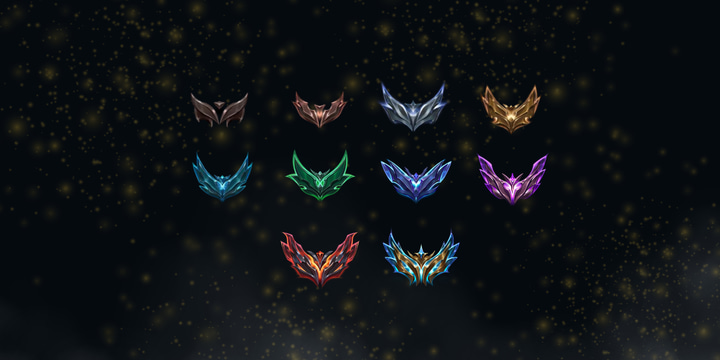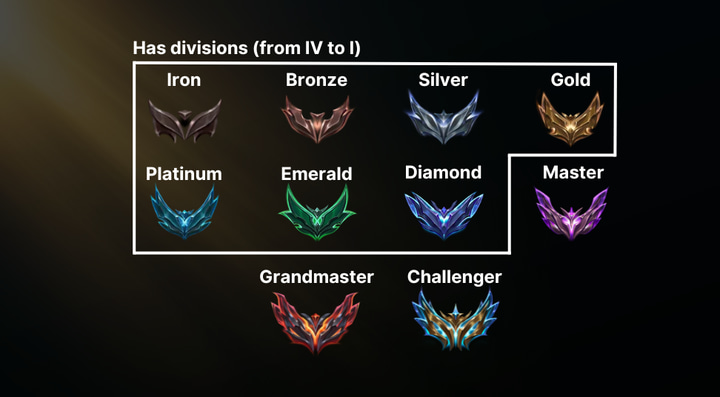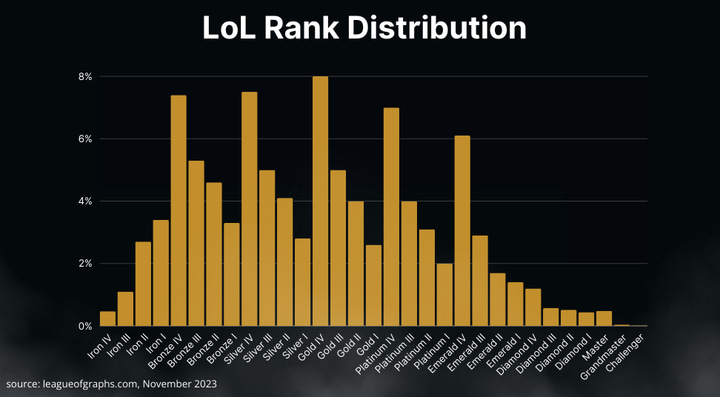League of Legends Ranks Explained

Since its release over a decade ago, League of Legends has amassed and maintained a devoted fanbase of millions of players. Even today, it continues to attract new players who want a piece of the action. Given its success, it is easy to see why League of Legends is so appealing to newer players; the combination of strategy, action, and chaos makes it worthwhile and enjoyable, and every day there are tons of players looking to climb the League of Legends ranks.
Being a competitive esports title, League of Legends has a complex ranking system. It was designed to match players of similar skill levels with one another in order to keep the game fair. For a beginner, understanding the ranking system can be confusing. This article explains the entire League of Legends ranking system, including all ranks, divisions, and much more.
League of Legends Ranks Explained
Understanding the League of Legends ranking system can be difficult for new players. There are various ranks and divisions to be aware of. VALORANT’s ranking system (see VALORANT Ranks Explained) most closely resembles the League of Legends ranking system. Because they were created by the same developers, their ranking systems share many similarities.
The rank system of League of Legends is divided into ten main rank tiers:
- Iron
- Bronze
- Silver
- Gold
- Platinum
- Emerald
- Diamond
- Master
- Grandmaster
- Challenger
Each rank is divided into four divisions, numbered one to four, with Division 4 being the lowest and Division 1 being the highest. To move to the next rank, you need to climb through each division of that rank. You need 100 LP (League Points) to climb out of each division.
When you win games, you gain LP, and when you lose games, you lose LP. The amount of LP you earn per win is determined by your game performance and the skill level of your lobby.
For example, if you are a Platinum player in a Diamond lobby and win, you will receive a large amount of LP. The reverse is also true: if you’re a Diamond player and you lose against a Platinum team, you’ll lose a lot more LP.
You also lose LP as a penalty for abandoning the game or going AFK, so avoid that.
How to Unlock Master, Grandmaster, and Challenger Ranks
The ranking system works as explained above until Diamond. You win games, earn LP, and climb up through each rank and its division.
After Diamond, the system changes though. You still earn LP, but ranking up is a completely different affair and there are no more divisions.
When you have reached Master, to climb to Grandmaster you will need a lot more than 100 LP. The minimum entry for Grandmaster rank is 200 LP, and 500 LP for Challenger. On top of that, both of these ranks are given to only a certain number of players. This number differs from region to region. For example, the EUW Challenger holds the top 300 players in the region, while Grandmaster holds 700 players.
To hold your rank, you need to keep playing and stay within this top ladder. You also lose LP points if you don’t play a match for some time. Though this is a strict system, it rewards players who put in the effort to stay at the top.
Grind, improve, and put in the time, and you will be there too. It’s all about persistence and dedication.

How to Unlock My Rank in League of Legends
New players first need to hit level 30 to unlock ranked. Riot put this system in place to stop smurfs and to help newer players familiarize themselves with the game before getting into competitive lobbies.
Once you have unlocked the ranked mode, the next thing you’ll do is play placement matches. You play ten placement matches where Riot calculates your skill level, and after those matches the game will give you your rank. Make sure to focus on your placement matches and perform well in them so you are placed in a good rank.
What is MMR in League of Legends?
MMR, or matchmaking rating, is a hidden number used by Riot Games to determine the skill level of a player. This is a number that you cannot see or find out, and it’s used in the background to set up fair matches at all times.
Your MMR also affects the amount of LP you gain. For example, beating a team of players with a higher MMR than you will result in you gaining more LP.
Your MMR goes up when you win a lot of matches in a row or perform well consistently. If you find yourself often queued with players that are ranked higher than you, this means you have a higher MMR than the average of your rank.
What are the League of Legends Ranked Seasons?
League of Legends releases a new season every year. Each season features map improvements, new champions, and other improvements in different mechanics.
Each season is divided into two splits. In each split, players compete and climb up the ranked ladder to earn rewards. At the start of the first split, there is a hard reset. This means that the MMR and LP of all players is set to 0. In order to unlock your rank again, you need to play placement matches.
At the start of the second split, there is another reset. This is a soft reset, meaning your LP and MMR are lowered instead of reset to zero. You will still be unranked and have to placement matches though.
League of Legends End-of-Split Rewards
At the end of each split in a season, players are given free rewards. As you play the game you will earn Skill Points, or SP. You can then use your SP to get rewards like emotes, skins, and chests. Players also earn free rewards as they play, which can be tracked on their skill progress bar.
Apart from this, there are the honor skins. The honor system was implemented by Riot Games to reward players who keep the game environment friendly and positive. Reaching the Honor Level 5 at the end of each split gets you a free skin. You are not only rewarded for playing well but also for being a good and positive team player.
Rank Distribution
Before 2023, a season lasted the whole year, which made the distribution bottom heavy, with 60% of the players in Gold or below. In 2023, Riot Games implemented the Split system, breaking the season into two even splits and adding two resets. Additionally, they also added the new Emerald rank, which aimed to make the rank distribution a bit more even.
As you can see below, the regular ranks are pretty evenly spaced out, with the top ranks (the so-called ‘Apex Tiers’) being reserved for only the absolute best players.

Solo, Duo and Flex Queue Explained
There are three ways to queue in a ranked match – solo, duo, or flex queue. Solo means that you queue up alone and Duo means that you’re with a friend. You will be matched with randoms so keep that in mind.
If you have more friends, you are going to have to Flex queue. You can queue with three people or five people, but a four-person queue does not exist.
Conclusion
The League of Legends ranking system might be confusing at first, but when you first start playing, you will understand it gradually. Obviously, to reach the higher ranks, you will have to grind and put in hours learning and understanding the game. After reading this, you will have a good understanding of the ranked system in League of Legends. So, continue grinding, and you will reach your goal rank!



Great article!